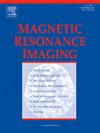Optimizing knee joint imaging: A comparative study of 7T MRI sequences
IF 2
4区 医学
Q2 RADIOLOGY, NUCLEAR MEDICINE & MEDICAL IMAGING
引用次数: 0
Abstract
Purpose
To reduce long scan durations and improve patient comfort while maintaining image quality by assessing varying 7 T MRI sequences to optimize knee joint imaging.
Materials and methods
In this prospective study, healthy participants underwent knee joint scans using 7 T proton density fat-saturated (PD-FS), 3-dimensional double-echo steady-state (3D-DESS), and susceptibility-weighted imaging (SWI) sequences. We evaluated the signal-to-noise ratio (SNR) and contrast-to-noise ratio (CNR) of cartilage, meniscus, ligaments, synovial fluid, and adipose tissue and the imaging quality of cartilage, meniscus, and ligaments. Also, we assessed the concurrence reached by two independent evaluators using the intraclass correlation coefficient (ICC).
Results
Twenty participants [mean age, 25.6 years ±8.4 (SD); 13 women] were evaluated. The 3D-DESS sequence demonstrated the highest SNR for cartilage, ligament, joint fluid, and meniscus structures (P < .001). It performed similarly to the PD sequence for fat but outperformed the SWI sequence. The CNR analysis revealed that 3D-DESS produced the highest contrast between joint fluid and other structures (P < .001), followed by PD-FS, whereas SWI exhibited the lowest contrast. The SWI sequence demonstrated superior CNR between ligament and fat (P < .001). The PD-FS sequence exhibited the highest CNR between cartilage and meniscus (P < .001). Both observers reported substantial concordance in their evaluations (ICC > 0.7). The cartilage visualization was excellent in all sequences, with the SWI sequence displaying slight superiority (P < .05). The ligament and meniscus images were of the highest quality when using PD-FS (P < .001).
Conclusion
A combination of PD-FS and 3D DESS sequences is recommended for comprehensive and comfortable 7 T MRI assessments of knee joints, ensuring detailed visualization of various vital knee structures.
优化膝关节成像:7T MRI序列的比较研究。
目的:通过评估不同的7 T MRI序列来优化膝关节成像,减少长时间扫描时间,提高患者舒适度,同时保持图像质量。材料和方法:在这项前瞻性研究中,健康参与者接受了7 T质子密度饱和脂肪(PD-FS)、三维双回声稳态(3D-DESS)和敏感性加权成像(SWI)序列的膝关节扫描。我们评估了软骨、半月板、韧带、滑液和脂肪组织的信噪比(SNR)和对比噪声比(CNR),以及软骨、半月板和韧带的成像质量。此外,我们使用类内相关系数(ICC)评估了两个独立评估者达成的一致性。结果:20名参与者[平均年龄,25.6 岁±8.4 (SD);对13名妇女进行了评估。3D-DESS序列显示软骨、韧带、关节液和半月板结构的信噪比最高(P 0.7)。所有序列的软骨显示效果都很好,SWI序列显示出轻微的优势(P 结论:建议结合PD-FS和3D DESS序列进行全面舒适的7 膝关节T MRI评估,确保各种重要膝关节结构的详细显示。
本文章由计算机程序翻译,如有差异,请以英文原文为准。
求助全文
约1分钟内获得全文
求助全文
来源期刊

Magnetic resonance imaging
医学-核医学
CiteScore
4.70
自引率
4.00%
发文量
194
审稿时长
83 days
期刊介绍:
Magnetic Resonance Imaging (MRI) is the first international multidisciplinary journal encompassing physical, life, and clinical science investigations as they relate to the development and use of magnetic resonance imaging. MRI is dedicated to both basic research, technological innovation and applications, providing a single forum for communication among radiologists, physicists, chemists, biochemists, biologists, engineers, internists, pathologists, physiologists, computer scientists, and mathematicians.
 求助内容:
求助内容: 应助结果提醒方式:
应助结果提醒方式:


